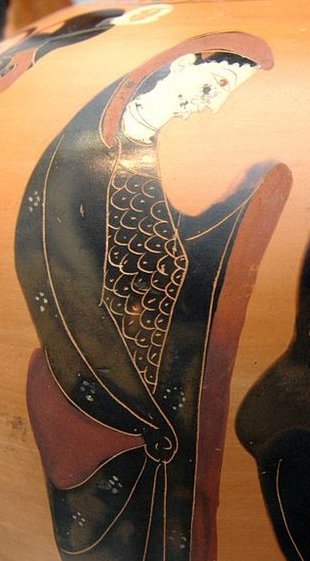Once again. Possibly heliacal time did not continue beyond midsummer, from where instead the stars determined time according to the old rules. The Sun time was only for a short while, beginning and ending in the same way year after year, like a kind of parenthesis - although a very important such.
In this picture the carrier of the year (Sisyphus) embraces more than half of the whole 'stone', perhaps meaning summer had 7 months instead of 6. Behind his back and above the fist of Merope were not tau ono (six stones, the Pleiades) but 7: ... According to mythology, Alcyone and Celaeno were both seduced by Poseidon. Maia, the eldest and most beautiful of the sisters, was seduced by Zeus and gave birth to Hermes; she later became foster-mother to Arcas, son of Zeus and Callisto. Zeus also seduced two others of the Pleiades: Electra, who gave birth to Dardanus, the founder of Troy; and Taygete, who gave birth to Lacedaemon, founder of Sparta. Asterope was ravished by Ares and became mother of Oenomaus, king of Pisa, near Olympia, who features in the legend of Auriga. Hence six Pleiades became paramours of the gods. Only Merope married a mortal, Sisyphus, a notorious trickster who was subsequently condemned to roll a stone eternally up a hill ... ... Merope often is considered the Lost Pleiad, because, having married a mortal, the crafty Sisyphus, she hid her face in shame when she thought of her sisters' alliances with the gods, and realized that she had thrown herself away. She seems, however, to have recovered her equanimity, being now much brighter than some of the others. The name itself signifies 'Mortal' ... Instead of 366 (a more practical value than 365¼ days for the cycle of the year) it could have been more reasonable to continue beyond midsummer according to a cycle of 384 nights (rounded upwards from 383½). 192 (Ga7-23) = 384 / 2:
Haedus II at Ga7-24 was close to the Full Moon (i.e. in its nakshatra position) and we have earlier discovered nakshatra Sirrah at Gb5-8 and nakshatra Bharani at Ga6-19 (whereas Hamal at Gb7-28 was heliacal):
There maybe was a change from heliacal to nakshatra in the interval between Gb7-28 and Ga5-8, and the glyphs (and myth) suggest this might have happened at the June solstice, when Sisyphus had brought his 'stone' all the way up to the top:
July 7 (188) was said to be the last day of the month in which Jupiter expired: ... Midsummer is the flowering season of the oak, which is the tree of endurance and triumph, and like the ash is said to 'court the lightning flash'. Its roots are believed to extend as deep underground as its branches rise in the air - Virgil mentions this - which makes it emblematic of a god whose law runs both in Heaven and in the Underworld ... The month, which takes its name from Juppiter the oak-god, begins on June 10th and ends of July 7th. Midway comes St. John's Day, June 24th, the day on which the oak-king was sacrificially burned alive. The Celtic year was divided into two halves with the second half beginning in July, apparently after a seven-day wake, or funeral feast, in the oak-king's honour ... June 24 can be written 6-24 (with 62 * 4 = 248 = 8 * 31). In Ga7-24 (SEPTEMBER 30) another multiple of 24 occurs. (6 + 7) * 24 = 13 * 24 = 312 (= 314 - 2). South of the equator there were 6 Pleiades sisters, but in the north there were 7. June 21 was 456 (= 19 * 24) days after 0h in the preceding year. (19 - 7) * 24 = 12 * 24 = 288 (October 15) and possibly the day when king Hotu arrived to Easter Island. 288 = 188 (July 7) + 100. 600 (Tau Ono) - 456 (= 38 * 12) = 144 = 12 * 12 = 288 / 2. The front 'feathers' of Merope seem to be 39:
However, since the time of Gregory XIII the stars should have advanced with 4 precessional days and this fact ought to make us look for dates around 4 positions later than Ga1-29 in the text:
The decapitated man in Ga1-29 (where APRIL 19 was 29 days after 0h) could in some way have corresponded to the day when the Oak King was burned alive. 5 glyphs later Vega was close to the Full Moon.
|
||||||||||||||||||||||||||||||||||||||||||||||||||||||||||||||||||||||||||||||||||||||||||||||||||||||||||||||||||||||||||||||||||||||||||||||||||||||||||||||||||||||||||||||||||||||||||||||||||||||||||||||||||||||||||||||||||||||||||||||||||||||||||||||||||||||||||||||||||||||||||||||||||||||||||||||||||||||||||||||||||||||||||||||||||||||||||











